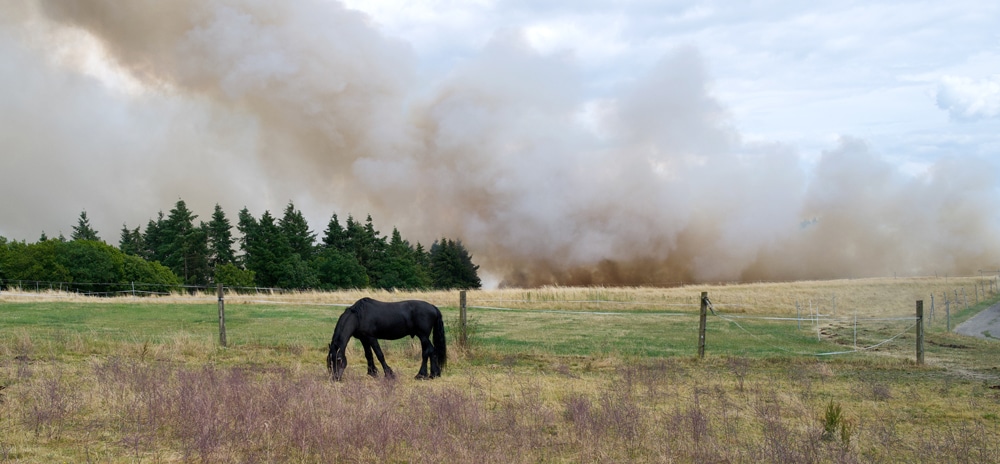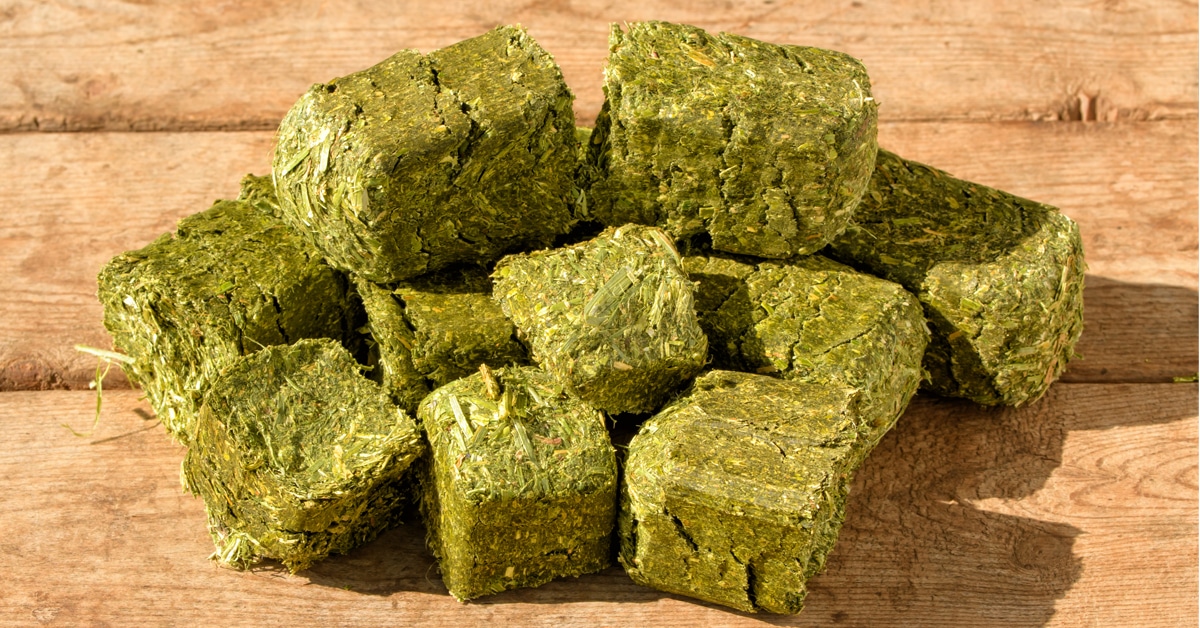Forage is the preferred basis of a horse’s diet, and the majority of horses will thrive on hay and/or pasture, otherwise termed ‘long-stem fibre’. However, there are certain situations which warrant the use of forage alternatives, commonly referred to as preserved forages and/or complete feeds. These products are fibre sources that still rely on digestion by microbial fermentation in the hindgut, similar to hay or pasture.
When feeding forage alternatives, it is crucial that the horse’s fibre requirement is being met for proper gastrointestinal tract function. When a horse is maintained on hay or pasture as the base of their diet, they have no issue meeting this requirement; however, when forage begins to be replaced with alternatives there are some key considerations for health.

Drought, fires, and flooding increasingly impact hay production and pasture availability. (Turner – stock.adobe.com)
Why would hay or pasture need to be replaced?
There are a variety of reasons why an owner may be investigating the feasibility and suitability of forage alternatives. Horse owners have heard the phrase ‘make hay while the sun shines’, and when there are extreme weather conditions such as drought or flooding, the impact on hay production can be significant and result in a serious hay shortage, and also impact pasture forage availability and quality. This is an event where horse owners may turn to forage alternatives to make their existing hay last longer, or to completely replace the hay in their horses’ diets if necessary.
Another situation in which forage alternatives are frequently used is when travelling for extended periods of time. It can be challenging to ensure that you have a consistent source of quality fibre nutrition for your horse, so incorporating some of these alternatives can be both convenient and beneficial.
Some health conditions warrant a reduction or removal of hay from the diet. Poor dentition, chronic digestive issues, and inflammatory airway disease are a few examples. When a horse is unable to grind long-stem fibre adequately it may result in choke and weight loss and replacing hay with a processed forage alternative can reduce the chewing requirement. With chronic digestive issues such as free fecal water syndrome, using a forage alternative can provide a more readily-digestible source of fibre to the horse. These forage replacements can also be a great option for horses with respiratory issues as they are lower in dust and can be thoroughly soaked!
Another reason may simply be to mix powdered supplements with, or as an additional source of protein or calories. They are also a great avenue to increase water intake, as many of the forage alternatives discussed are fed soaked.
Fibre Length
A key consideration before using a forage alternative is the horse’s fibre length requirement and need to chew. When the fibre length is long (normally 2+ inches), the time the horse spends chewing will be longer. Chew time is critical for horses as they do not salivate in anticipation of food like humans do. For horses, the chewing motion activates saliva production.
Regular production of saliva is critical for horses as gastric acid is continually secreted in their stomach due to them evolving to be trickle feeders. The saliva not only moistens the feed, but also acts as a gastric buffer. Therefore, when long-stem fibre such as hay is replaced with these alternatives that require less chewing, it can negatively impact the gut health and increase the risk of gastric ulcers. Since less chewing is required, horses will consume these forage alternatives faster than they would consume hay; if a forage alternative is making up a significant proportion of their diet, it will need to be divided into small, frequent meals to avoid prolonged fasting periods.
Types of Alternatives
Hay cubes are a common go-to as the fibre length is longer than in hay pellets. The fibres have been chopped into shorter lengths and compressed into a rectangle or cube. Normally, hay cubes will consist of timothy, alfalfa, or a mix of both. Soaking hay cubes before feeding is recommended to reduce the likelihood of choke.

Beet pulp. (madbarn.ca)
Hay pellets take the processing aspect a step further, as the particle size is even smaller. They are not considered a source of long-stem fibre but are easy for horses to chew and swallow. These pellets can also be soaked. With both hay cubes and hay pellets you can find ‘plain’ options that are simply the chopped and compressed forage, as well as fortified options that include additional vitamins and minerals.
Beet pulp is another option that many horse owners will turn to. It tends to be higher in caloric content as a fibre source, readily digestible and calcium-rich, although low in protein (8-10% crude protein), vitamins and other minerals. It is not recommended that beet pulp be the primary fibre source and should not exceed 50% as a replacement. It is a great source of highly-digestible fibre and can be used to increase water intake since it is soaked prior to feeding. It is also considered a prebiotic beneficial to the microbes in the horse’s hindgut.

Complete feed.
Complete feeds are a little bit different, as they are specifically designed to be fed as the sole source of nutrition in a horse’s diet. These products are designed to be provided in large quantities in cases where no hay is given to the horse whatsoever – about 1.5-2% of total body weight daily (so roughly 18-24 lbs/8-11 kgs for a 1,200-lb/545-kg horse). These products are carefully balanced and fortified with protein, vitamins, and minerals. The forage portion of a complete feed is usually supplied by high-fiber by-products like beet pulp, soybean hulls, oat hulls, almond hulls, rice hulls, wheat bran, and so on.
Hay cubes or complete feeds are used most frequently when hay and/or pasture is completely removed from the diet. Pellets and beet pulp are recommended for partial replacements, but should not be the sole source of fibre in a horse’s diet.
Overall, your unique situation will determine which type of forage alternative is best. If you have questions on how to optimally use the forage alternatives discussed in this article, consult your veterinarian or a qualified equine nutritionist.

